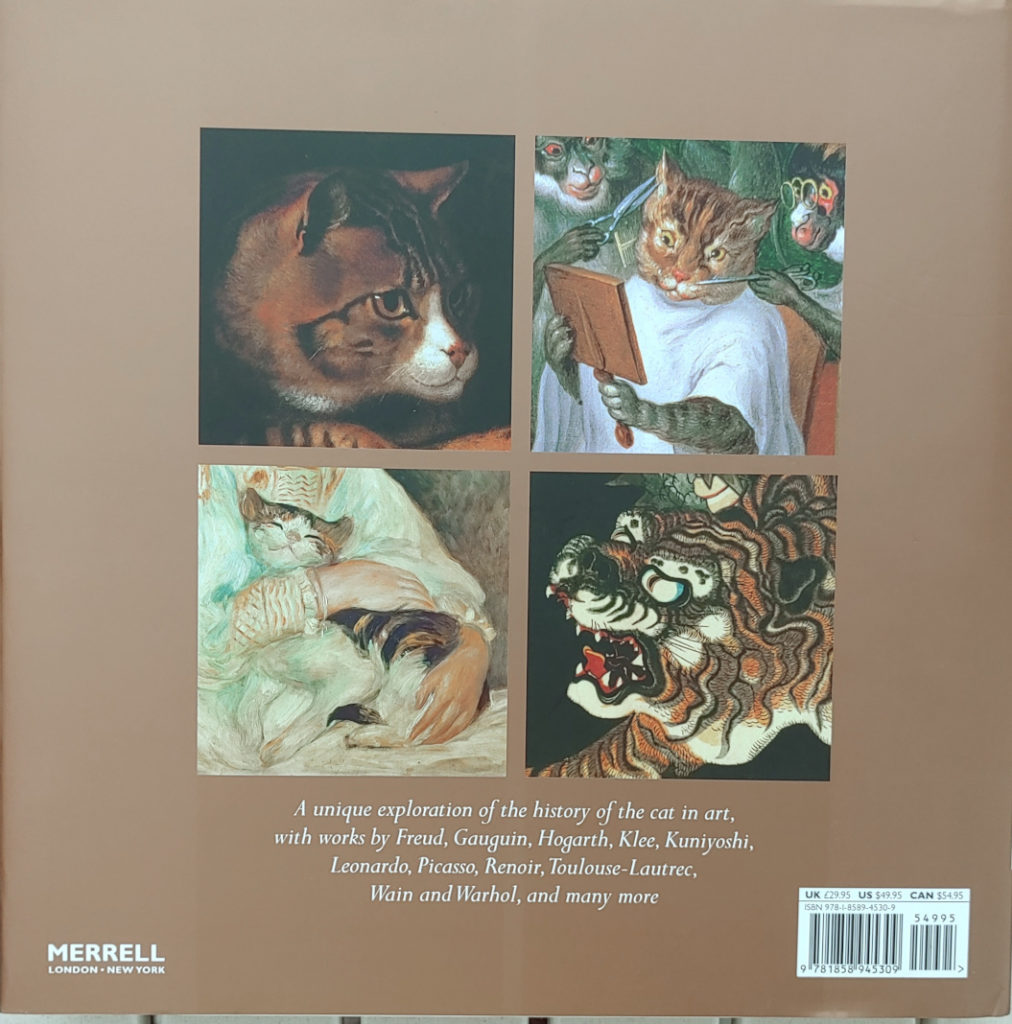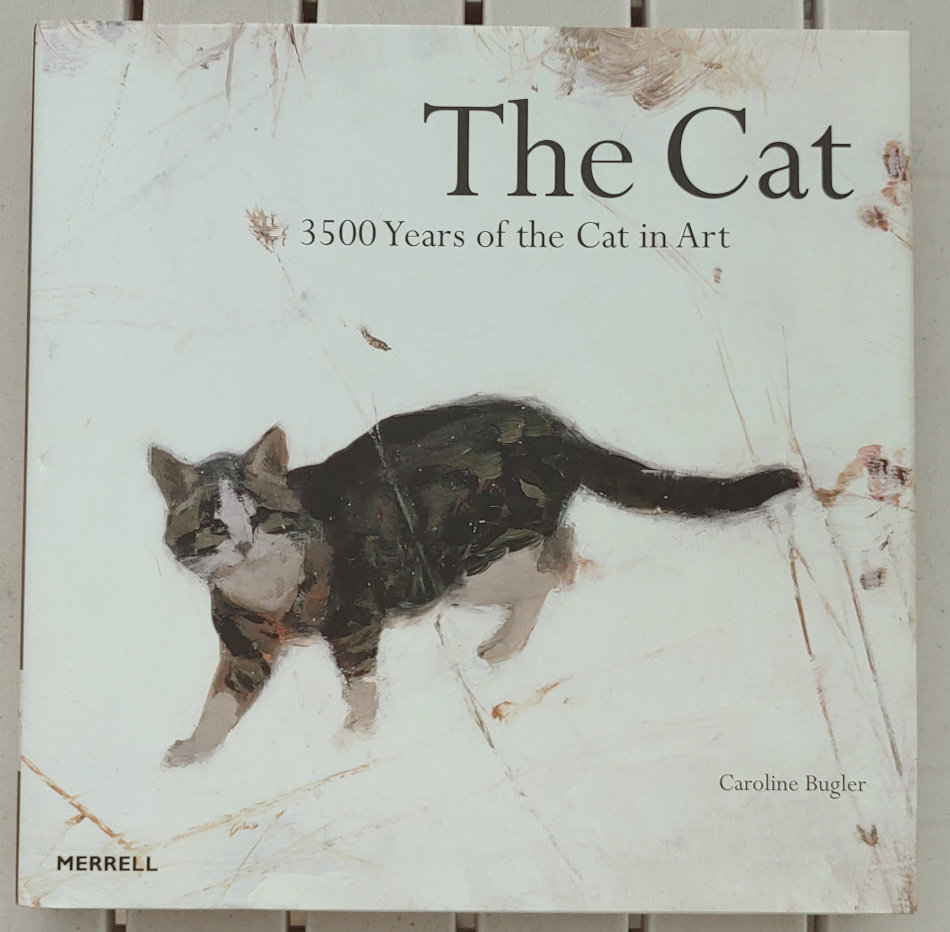The social media age made cats the most loved YouTube stars, just think of “Grumpy Cat” and the likes. In the many centuries before, the cat in art was second to horses and dogs, as Caroline Bugler explains in her fascinating book “The Cat, 3500 Years of the Cat in Art”.
Some of the facts stated in the books are absolutely logic when one gives them a minute of observation – like the fact that cats were never status symbols like horses or well-known companions of their owners. In that way dogs became a part of many pictures of their masters.
A cat has a private lifestyle, untameable and therefore not easily presented by an owner seeking adulation from spectators.
If there would have been many more cats like lovely Bob, who tended to sit on the shoulder of his owner James Bowen and accompanied him everywhere, the cat would have been much more in the focus before. In the case of cat Bob, he became the star of books and his owner was photographed because of him, not only with him. If those names do not ring bells with you, google the pair. It is worth it, although Bob has sadly died some years ago.
It needed smartphone cameras, YouTube, movies and video clips to capture the lively presence of the cat better than any painting could. There are indeed only few paintings in the book that do capture the cat like a photograph or a video does – one of them was created by Bruno Liljefors, a Swedish artist who loved to show cats in nature. It is not the one that was used as the books front cover – “Cat Stalking over Snow” from the year 1884, but one only shown inside on page 170. It depicts a cat in the moment of catching a little bird – claws wide, teeth barred, eyes wide open – better than any photograph. Understandably the publishing house chose a tamer painting for the front cover. “A Cat and a Caffinch” from the year 1885 would have certainly got a few negative reactions or less buyers. In my opinion it is the best painting in the book. On of the other really good ones is shown on the back cover, Abraham Cooper’s “A Tabby Cat” from the year 1817. The alert and intense view of the cat is beautifully caught, as well her elegant paw.

Today is more of an age of the cat than the many long centuries before, actually since the old Egyptians. This is correct at least for the Western side of history, where cats became less and less loved after the early Egyptian peak in admiration. This love for cats seems to have come out of nowhere, thousands of years before, when the Egyptians started with agriculture and the cat decided that hunting mice outside in the fields was less of a good life than eating from the table of humans inside. So, or similar it must have been, as Caroline Bugler describes it in her book. With that bold move an unprecedented ascent in sympathy started, peaking in cats being seen as God-like and condemning every human who killed a cat to death himself.
It was impossible to keep that standard, even the Greek and Romans who came after the Egyptians in high culture were less addicted to cats already.
The dramatic descent of the cat started with Christianity becoming the major religion. In the dark Middle Ages, the cat was linked to witches and the devil and cat-hating Popes and clergy gave them free for extermination. A boomerang effect of cats surviving better in the countryside than in villages and cities was the Plague – no cats meant many rats and they carried the fleas with the “Black Death”. This aspect – carefully shown by Caroline Bugler – is often elsewhere overlooked.
After centuries of persecution the cats came back from the wild to the houses of humans and never went away again. It is worthy to note that in Asia and Muslim countries cats were never as hated as in Christian countries and therefore did not endure such a deep fall.
Since the 17th and 18th century the cat was welcome again in Europe. Already towards the end of the 17th century one of the most beloved fairy tales involving a cat was written down – “Puss in Boots”. The French official and writer Charles Perrault collected stories from various sources and gave them a firm structure, “Puss in Boots” was one of them. It shows the cat as human-friendly and cunning. There are quite a few nice drawings from Gustave Dore depicting scenes from the fairy tale in Caroline Boulders book. I believe if a cat really loves you, everything it possible.
Today the cat has a firm place in the home of humans all over the world. Of course, in some countries cats have to work more as mice hunters than in others, but worldwide they are accepted as pets.
Through the social media and video culture the cats have found their medium to stardom. They have also not forgotten, deep in their genes, that once they were revered as Gods.
All rights to the book belong to:
Bugler, Caroline: The Cat, 3500 Years of the Cat in Art, published by Merrell London / New York, printed in China, year unknown, ISBN:978-1-18589-4530-9

